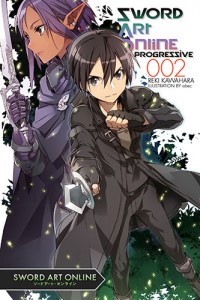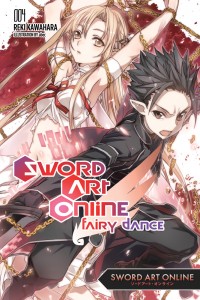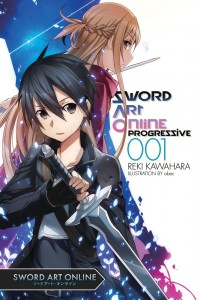By Reki Kawahara and abec. Released in Japan by ASCII Mediaworks. Released in North America by Yen On.
One of the problems with a series that’s narrated in first person, which Sword Art Online is (yes, sorry, Asuna fans, this is again all Kirito), is that it can be harder to see the flaws inherent in the protagonist, since you have to remove yourself from the narrative voice to see what’s really going on. Last time we saw Asuna starting out in Aincrad trying to find a noble way to die, and Kirito had to show her that there are better things to try for than that. But he has issues of his own – he’s bad at dealing with people, as he both admits himself and we see time and time again, making bad jokes in order to try to get past the fact that he finds it hard to gauge what others are thinking. And while I think he’s right that Asuna could grow to be a great inspiration to others trapped in the game, I worry he may be putting her on a bit of a pedestal, particularly as he tries to ensure the other players don’t see her as a villain.
Kirito is also having to have genuine interaction more than he expected, as the elf that they meet up with, Kizmel, not only doesn’t die – as she did in the beta Kirito played – but proves to be far more well-rounded and realistic than any NPCs he’s come across before. Both he and Asuna over the course of the book are amazed at how Kizmel grieves for the sister she lost, has mysterious, prophetic dreams, and seems to be having flashbacks to the beta test that Kirito participated in. This helps to show how SAO is not just another game, but it also lends a bit of intrigue to the series going forward, as this isn’t really explained much beyond “wow, Kayaba was a better programmer than we thought”. Luckily, without spoiling much, I will note that Kizmel survives, and I expect we’ll see her again in Book 3.
The other big focus of the book is the reveal of Morte, and what kind of player he is. Fans of the SAO anime and Japanese fans who read the books in order may be a bit ahead of those coming at the novels in NA-publishing order, as they are aware of the guild called ‘Laughing Coffin’. I’m pretty sure that’s what we’re seeing the genesis of here, as Kirito chillingly runs into a player who simply has the desire to kill, because he realizes that he can do it here and get away with it. The duel itself is the high point of the novel, menacing, action packed, and a bit terrifying. After that, we get a fight that doesn’t arise, as Kirito (and Asuna, who thankfully tails after him when he’s being a loner idiot) talks down two nascent guilds from fighting against each other and helps them realize the goal is for everyone to work to escape the game.
As for my review, those who read me regularly know the less I talk about the actual qualities of the book and the more I theorize, the better I like it. Sword Art Online Progressive’s prose is more mature than the original works, its steady pace (we only get one floor this time around) allows it to grow more naturally, and Kirito and Asuna are clearly destined for each other but are both in denial, which is cute. (For a killer drinking game, try drinking every time Asuna elbows Kirito in the gut. Actually, don’t do this.) Honestly, I’d recommend this series to an SAO newbie first, even if it does have a lot of callbacks. Probably my favorite SAO novel to date.



